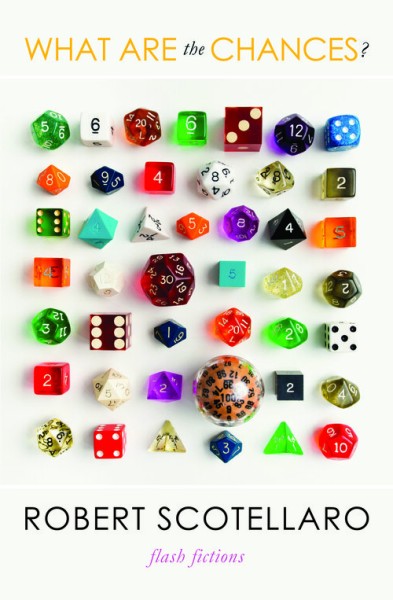
by Frannie McMillan
The almost 70 stories that make up Robert Scotellaro’s most recent book, What Are the Chances? (Press 53, 2020) are populated by the kind of imperfect, floundering characters one might find in a Raymond Carver story, except that a more pronounced warmth and humor softens their edges. Most bring with them a lifetime of former spouses and lovers, distant adult children, various occupations ranging from the mundane (shoe salesman) to the bizarre (rodeo clown), vast collections of knickknacks, abandoned aspirations, all manner of animal companion, and childhood memories. Scotellaro’s epigraph, a quotation from the American realist painter, Andrew Wyeth, gives readers notice that this is a collection of stories with a focus on characters in the fall and winter of their lives, and that even nearing the final quarter of life, even as crows and flies gather on the pages where their tales are inscribed, “[…] the whole story doesn’t show.” For readers of any age, the message that life’s small, miraculous moments of joy don’t simply cease after challenging circumstances, or after our bodies are no longer pretty, flexible things, or after we’ve become so very, very tired–this is a message of hope without being too saccharine, pointed, or pedantic. As the title suggests, the overarching theme in this collection is a look back at circumstances that–in hindsight–are sometimes as funny or ridiculous as they are bittersweet or painful. And yet, each story is also doggedly hopeful. There’s a sense of the shoulder shrug at life’s assorted mishaps before the story turns and looks forward to whatever lies ahead, considering the chances that things might get better.
Many of the details in these stories have to do with what’s going on in the background, and how the mundane details ground a person when everything else spins out of control. One example is in “Dear God (A Love Story),” when the speaker’s ex-wife shows off her new talent for yodeling: “[…] her yodeling competes with a tree full of noisy birds, and a jet overhead, a garage band […].” The scene is set against this suburban backdrop that feels familiar and predictable. Scotellaro zeroes in on what happens between a couple in the long term, names so exactly the sneaky distance that builds when two people are too close for too long: “She was once my wife and now she is just my daughter’s mother. Everything in between has burned up in some desert when I wasn’t paying attention, sucked up by some saguaro cactus, dangerously unapproachable.” The speaker is aroused by her yodeling (which is hilarious on its own), and in the time and space that has lapsed between their broken marriage, he learns to appreciate her again, thinks “I’d love to get her back with some magnetic brilliance machine I haven’t yet invented. See again what was once in those same eyes, only younger, that looked at me so differently.”
Many of Scotellaro’s characters wear costumes or literal masks, as in “Mr. Nasty,” “Oven Gloves,” “A Penchant for Renegades,” “Death’s Late-Night Walks,” “Fake Eunuch,” and “Bad-Boy Wannabe and The Cephalopod Empire.” Others don neckties, decorate their bodies with ink, apply bright lipstick or funky sunglasses–adding a physical layer while also exposing a character’s inner workings. For example, in “Death’s Late Night Walks,” which is one of the shorter stories in the collection, Scotellaro delivers a portrait of a man who wears a Grim Reaper costume while walking his red-sweater-wearing chihuahua named Clarence. The little details here, like the tiny dog’s sweater having been knitted by “Death’s wife,” and the scythe he carries as he walks past the pot-smoking teens in the children’s playground, give readers the sense that this is a character with a wicked sense of humor, who is learning to get comfortable with the specter of Death himself and having fun in the process.
Scotellaro also incorporates repeated images–red lipstick around a straw, on the mouth of a beer bottle or a laughing woman, crucifixes, birds, insects, and a few pets who are as busted up as their human counterparts. These images echo back and forth among the stories. In “Transplant,” a woman with a new heart sits in a lawn chair on a day “so windy, it seemed to be blowing the crows from the trees” as they cawed and moved like “black swipes to a new perch.” Later, in “Somewhere Beneath It,” a girl speaks into a conch shell as a “crow’s shadow paints a handlebar mustache” on a bed sheet hanging from the clothesline. The overall effect of these repeated references is that readers can’t help but see the connection between a woman with a new heart, a new lease on life and the crows that “blew from a poplar, black smears from one yard to another,” to the young girl who imagines she is speaking to a mermaid inside a conch shell as she waits out her parents’ argument in her own backyard.
By the end of the collection, readers feel at ease about the march of time and the hardships of a life lived long enough to experience heartbreak, trauma, disappointment, and the other heavy negatives that so often become the human focus because Scotellaro shows us story after story of the small, redeeming moments that buoy a person’s spirits, that bring us back to that basic, glad warmth of simply being. The collection’s final story, “A Purgatory Dweller’s Guide to Bird-Watching,” drives this home: “And the only thing that saves the day, besides the six-pack patient in the fridge, is when you walk the dog and turn at just that right moment. See a sparrow, high above the tree line, […] landing inside a diamond in a chain link fence a foot away.” Readers will appreciate Scotellaro’s ability to paint these moments and details with an accuracy that grants us agency to find them in our lives as well.
____________________________
 Frannie McMillan’s poetry has appeared in The Coachella Review, K’in Literary Journal, The Indianapolis Review, and others. She is currently at work on her first chapbook, You Ain’t By Yourself. By day, she connects young people with books as a secondary librarian in Richmond, Virginia. You can find her on Twitter @franniemaq.
Frannie McMillan’s poetry has appeared in The Coachella Review, K’in Literary Journal, The Indianapolis Review, and others. She is currently at work on her first chapbook, You Ain’t By Yourself. By day, she connects young people with books as a secondary librarian in Richmond, Virginia. You can find her on Twitter @franniemaq.

 The SmokeLong Grand Micro Contest (The Mikey) is now an annual competition celebrating and compensating the best micro fiction and nonfiction online.
The SmokeLong Grand Micro Contest (The Mikey) is now an annual competition celebrating and compensating the best micro fiction and nonfiction online.